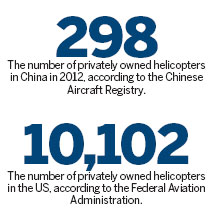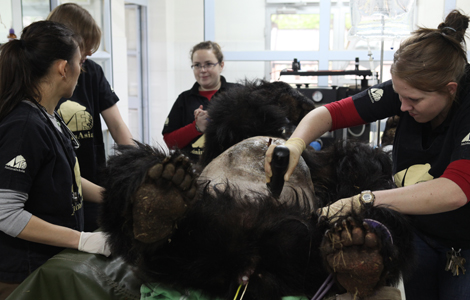Sky's the limit for whirlybirds
Updated: 2013-08-09 12:45
By Chris Davis (China Daily)
|
||||||||
|
General aviation helicopters like the Bell 407 (pictured) are coming on strong in China, as the military's restrictions on air space under 4,000 meters eases and people are looking for new ways to spend their money getting from point A to B. Several unique factors make China an ideal market for helicopters, whose numbers there are expected to skyrocket over the next 20 years. Courtesy of Bell Helicopter |

With the opening of its air space, China will become the world's biggest market for helicopters, though it will need to address problems, including a lack of pilots and red tape over delivering the aircraft, reports Chris Davis from New York.
When it comes to the prospects for general aviation in China - "general aviation" being anything flying that is not military or commercial - the sky's the limit. Literally. China's military has complete control of the airspace and has been fairly restrictive over its use. Now that is changing.
Plans to open the space up to 4,000 meters are part of China's current five-year plan, according to Jens Hennig, vice-president of operations for the Washington-based General Aviation Manufacturers Association (GAMA), the industry trade group representing non-military and non-airliner aircraft manufacturers, chiefly in the United States.
That fairly low ceiling coupled with China's relative scarcity of air strips make one type of private flying machine more preferable than any other: the helicopter. And China is poised to become the world's biggest market for whirlybirds, though the country needs instructors, pilots, maintenance technicians and less bureaucracy for companies seeking to deliver the rotorcraft.
Chinese customers are showing "significant interest" in acquiring helicopters, Hennig said, and that interest will be on display next month when 250 companies from around the world are expected to show their products at the China Helicopter Exposition from Sept 5-8 in Tianjin.
Booming Demand
Helicopter manufacturers have long anticipated a booming demand for whirlybirds in the world's second-largest economy. Eurocopter Group, the world's largest helicopter manufacturer, established an office in China in 2006. Of the fewer than 300 helicopters in general aviation in China, 98 are Eurocopter products, and 14 of them are the $4 million-to-$5 million EC 135 luxury model, which has a non-stop range of 570 miles.
Texas-based-based Bell Helicopter entered China in 1979 with eight helicopters and now sells three models there. "China presents the largest potential growth market in rotorcraft history," a Bell spokesman wrote in response to e-mailed questions from China Daily.
Sikorsky said it has been "highly successful in China for the past decade", noting that there are 31 S-76s and four S-92s in various configurations plying the skies over China.
There were only 298 privately owned helicopters in China in 2012, according to the latest figures from the Chinese Aircraft Registry. By way of contrast, the Federal Aviation Administration counted 10,102 in the US in the same year. China's newfound attraction to helicopters has a number of reasons; a rash of natural disasters is one.
"Devastating earthquakes like the ones in Sichuan in 2008 and 2013 provide prime examples of how helicopters can access toppled buildings, blocked roads and destroyed railways and bridges," the Bell spokesman wrote in his e-mail. "Helicopter emergency medical-service providers can travel roughly twice the speed of a ground ambulance. Factoring in traffic in densely populated areas, helicopter transport is significantly faster."
"We noticed a few years ago, when there were some natural catastrophes in China, an increased interest from the Chinese delegations in better understanding the use of helicopters for disaster response," said Hennig.
Prior to that, he said, most interest from China in general aviation overall had been for training commercial pilots, for getting back and forth from the remote western regions of the country or for "the recreational, the fun part of flying".
Hennig said both Bell Helicopter and Eurocopter Group are selling helicopters in China for transportation as well as disaster response.
"We are truly feeling the warmth of the fast-growing helicopter market here," Ed Beyer, vice-president of Sikorsky Global Helicopters, said at last year's Airshow China when the company signed two contracts with Ruili Jingcheng Group, a private conglomerate based in Ruili, Yunnan province in southwestern China. Beyer called the deal a major milestone for Sikorsky's business development in China.
The contracts were for the first-ever sale of a Sikorsky S-92 helicopter to a private Chinese operator and the first-ever Sikorsky S-76D helicopter sale into China. Both aircraft are most commonly used to shuttle to offshore oil rigs but will be configured for airline use. Ruili Jingcheng Group is expanding its business in the aviation sector by establishing three aviation subsidiaries, including a helicopter operating company.
China's lower airspace will open by 2020, according to a Bell press release. The company also cited figures from the country's Civil Aviation Administration that predict the number of civilian helicopters in China to grow by 25 percent annually over the next five years and reach 2,100 units by 2020.
Bell forecasts an estimated 100 "super medium aircraft" (like the Bell 525) will be delivered to the Asia-Pacific region over the next nine years, with 140 more over the following decade. Since 2010, Bell has delivered 26 helicopters in China, including 11 of its 407 models.
Maintenance training
One of the main challenges to helicopters becoming more widely used in China will be meeting the demand for pilots and maintenance technicians. The Civil Aviation Administration estimates that by 2020 China will need 6,300 helicopter pilots.
To help meet that need, Bell recently signed a memorandum of understanding with Guangzhou Civil Aviation College to become its first helicopter-maintenance training facility in China and a similar arrangement with Guanchen Aviation to be the first flight-training facility, which is expected to be operational by the end of this year. Both operations will focus on the Bell 206 and 407 models. Since 2008, 144 Chinese pilots have been trained at the Bell Helicopter Training Academy near Fort Worth, Texas.
China's offshore oil industry also is spurring the demand for helicopters and some operators are expecting to double the size of their fleets over the next couple of years, the Bell spokesman wrote in his e-mail. "Heavy industry needs access to larger helicopters capable of power-grid construction and airborne maintenance, gas pipeline laying and patrolling, agriculture and livestock management and firefighting in forested areas," he wrote.
Aside from increasing the flexibility of air space use, GAMA's Hennig said delivering helicopters to China needs to be made easier. "Our ability to deliver aircraft into China - a pretty rigorous and bureaucratic process that involves getting approvals from the Civil Aviation Administration of China - is pretty cumbersome," he said.
"But over time, as they learn more about helicopters and get more experience in approving aircraft, we hope that will lend itself to having an ability to deliver more aircraft into China and let it grow more naturally than it is today," Hennig said, adding that there were "some natural constraints, just as China is getting their arms around how to integrate general aviation into their aviation system, which is very much focused on commercial airlines and military flight operations today."
William Garvey, editor-in-chief of McGraw-Hill's Business & Commercial Aviation Magazine, said that the Chinese appetite for helicopters goes beyond imports, noting that Chinese interests bought the helicopter manufacturer Enstrom in Menominee, Michigan. Founded in 1959, the company was acquired by Chongqing Helicopter Investment Co in December 2012, with the mission of "helping Enstrom expand its reach into China and the rest of the world," according to a press statement issued at the time of the purchase.
Enstrom President Jerry Mullins said the deal would provide the company with "the needed resources to enhance marketing efforts in China and around the world." In May, the company announced it was expanding its 85,000 square-foot manufacturing facility by 77,000 square feet. With the expansion, Enstrom said it will add 150 to 200 new jobs and will have the capacity to increase production to 100 helicopters annually within the next few years.
Continental sale
In 2010, the Chinese company Technify Motor acquired Mobile, Alabama-based Continental Motors for $186 million. The purchase also included Continental's facilities in Fairhope, Alabama, and Mattituck, New York. Continental employed about 400 people at the time of the purchase.
Garvey said another reason helicopters have such a big and immediate potential in China is because there are so few airports.
The US has 5,000 airports, he said, whereas in China there are may be 200. "They are building more," Garvey said. "They've got a big building program going on. But if you consider the population and the number of major cities, it's just a handful of airports by comparison. So if you want to move around by air - and you're not traveling to a major city with an airport - helicopters are about the only option."

A sign of the growing use of helicopters in China is a new helipad by the Third Ring Road in Beijing that was opened by Capital Helicopter Co, which has one of the largest fleets of choppers in China, to shuttle its clients in and out of the city in style. Capital is the first to offer charter service in Beijing and another example of how operators are taking advantage of loosening restrictions on the use of low-altitude airspace in formerly no-go zones.
Despite the easing of air-space controls, chartering still requires navigating through red tape. A customer needs to book a charter one day ahead to give the company enough time to deal with procedures required by the Air Traffic Management Bureau. As the demand for charter services rises, deregulation is expected to shorten the advance booking time.
Capital Vice-President He Chi said he expects the company's charter business to grow by 20 percent a year. Capital plans to expand its fleet of helicopters, which can land at any airport in the country and have an average range of 300 miles, to 21 from 14 by year end.
China's wealthy use such charter services rather than buy and fly their own helicopter, which is an expensive proposition. The cost of the aircraft aside, flying lessons can cost $32,100. But then chartering isn't cheap either. Capital charges $6,532 an hour with a maximum of five passengers, and one of their most popular new runs is the 90-minute flight from Beijing to Wutai Mountain, a tourist destination renowned for its Buddhist heritage.
"Rich people are tired of cars and golf," said Guan Xiwen, a helicopter instructor at the Guangzhou Suilian Helicopter Training Company in Guangdong province. "Flying is certainly much cooler.
Contact the writer at chrisdavis@chinadailyusa.com
(China Daily USA 08/09/2013 page20)
Most Viewed
Editor's Picks

|

|

|

|

|

|
Today's Top News
Pharm giant says it takes bribery claims 'seriously'
China's inflation rises 2.7% in July
Budget show cuts in provincial spending
US realty market 'connects dots' with China buyers
Pharm giant suspected of bribery
Economic prospects improved
Beijing rejects protest over patrol
China Unicom tests 4G network
US Weekly

|

|













